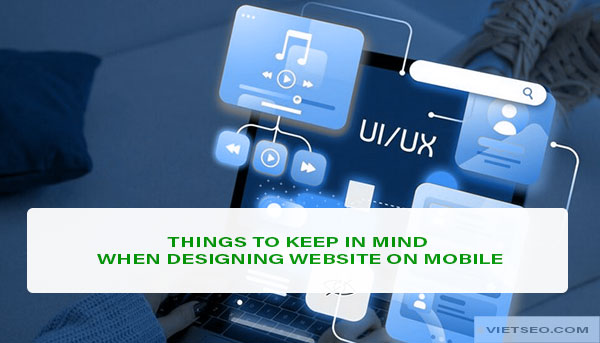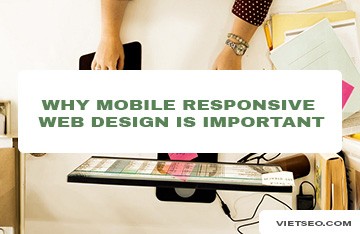Things to keep in mind when designing website on mobile
Fixing the following will help businesses optimize Website design on Mobile interface, improve user experience.
Website optimization for Mobile version is a mandatory requirement when building a Website. Because according to Statista statistics, mobile accounts account for more than 50% of Web traffic worldwide. This version is not optimized which means you could waste your marketing budget. And missed opportunities to reach potential customers. Not to mention, it also plays an important role in improving the customer experience.
To be able to optimize the Website on this interface, here are the points you need to note:
- Ease of operation
- Pay attention to create space when designing Website
- Website design in harmony, avoid distracting viewers
- Prioritize 1-column layout for best display
- Check Website Readability
- Double check the CTA and call button on the Website
- Use the correct number of fields to fill in when creating the registration form
- Short, concise title
1. Ability to operate easily
If the Web version you have more space to present the product catalog and calls to action like “Buy”, “Sign up now”, “Join now”. Then with the mobile interface, if not properly arranged, everything will become messy and complicated.
At this point, visitors may miss important links, call-to-action buttons or have to enlarge their already small mobile screens to interact with your Website.
Besides, when designing a mobile website, you also need to pay attention so that users can easily perform clicks. 75% of smartphone users use their thumbs to touch the screen. So make sure the buttons are big enough to press/tap with your fingers. The space between the buttons must also be just enough so that customers do not accidentally press the wrong button.
2. Pay attention to create space when designing Website
Creating space when designing Website on Mobile interface will help improve user experience: easier to read, easier to understand. These gaps often bring more open space, making it easier for users to grasp pieces of content quickly.
In addition, the space also has a visual effect, making the Website more attractive and the content more prominent.
3. Website design in harmony, avoid distracting viewers
On the small space of mobile devices, there is a lot of content you need to show, but arrange these elements in harmony (text, color images, ...) to avoid distracting viewers.
If factor A is already highlighted, factor B should be repressed. This will create contrast, attract viewers, help viewers focus more on watching.
4. Prioritize 1-column layout for best display
Phone screens are much smaller than computer screens, so design your Website so that users can read all the content without having to zoom in. The fix here is to prioritize a 1-column layout, make the most of the width of the screen and expand downwards.
This layout both helps display the best content and is convenient for users to scroll down (true to the habit of surfing the screen). To do this, you also need to remove cumbersome content, prioritizing important content and features.
5. Check Website Readability
To check the legibility of the Website, you can hold your phone away from a certain distance and see from that distance you can easily see the information you need to capture. From there, you can adjust the font, color, etc. so that customers can see the outstanding information even at a glance.
6. Carefully check the CTA and call button on the Website
For an effective mobile Web design, your call-to-action (CTA) buttons need to be visible. On a screen as small as a phone you shouldn't create too many CTAs.
Instead, think about your goals for each landing page. Are you trying to get more downloads? New registered email? New orders? Your CTA needs to focus on the main goal. Then, streamline the call-to-action as this will influence the customer's decision to click or skip.
In addition to focusing on the call to action, your call button needs to be visible. This is a useful feature to help customers contact you in case of need. Make sure the call button is clickable and when clicked the call will be made.
7. Reasonable use of the number of fields to fill in when creating the registration form
If you ask visitors for a lot of information, this is not an effective approach. Instead, you should change forms to make them concise and logical, minimizing text input.
Because, if a customer fills out a form on a computer that is not a problem, when doing it on mobile this sometimes causes a lot of inconvenience. In fact, filling in long and complicated information is the top reason why customers leave your site.
For example, if you are trying to get users to sign up to receive emails from your business, information such as phone numbers, home addresses, etc. does not need to appear. Or forms designed to collect customer information should not ask questions about payment information, shipping, etc.
8. Short, concise title
The title is an important element that is usually located at the top of the Web page and is displayed on all pages of the Website. These titles are the factor that attracts customers to Click so make them stand out with fonts or colors, …
In addition to the page title, when presenting Website content, the title should be concise, clearly showing the outstanding advantages/benefits of the product/service - what motivates customers to spend money.
Summary
And finally, make sure you carefully check the above factors before Publishing Website on Mobile interface. It's time to rethink your business website design on mobile version, optimized to make it easy for customers to find and manipulate. Improving this will definitely help businesses reach many new customers and increase revenue significantly.
Leave a Comment
Ways to Add Fonts to Your Website Effectively







